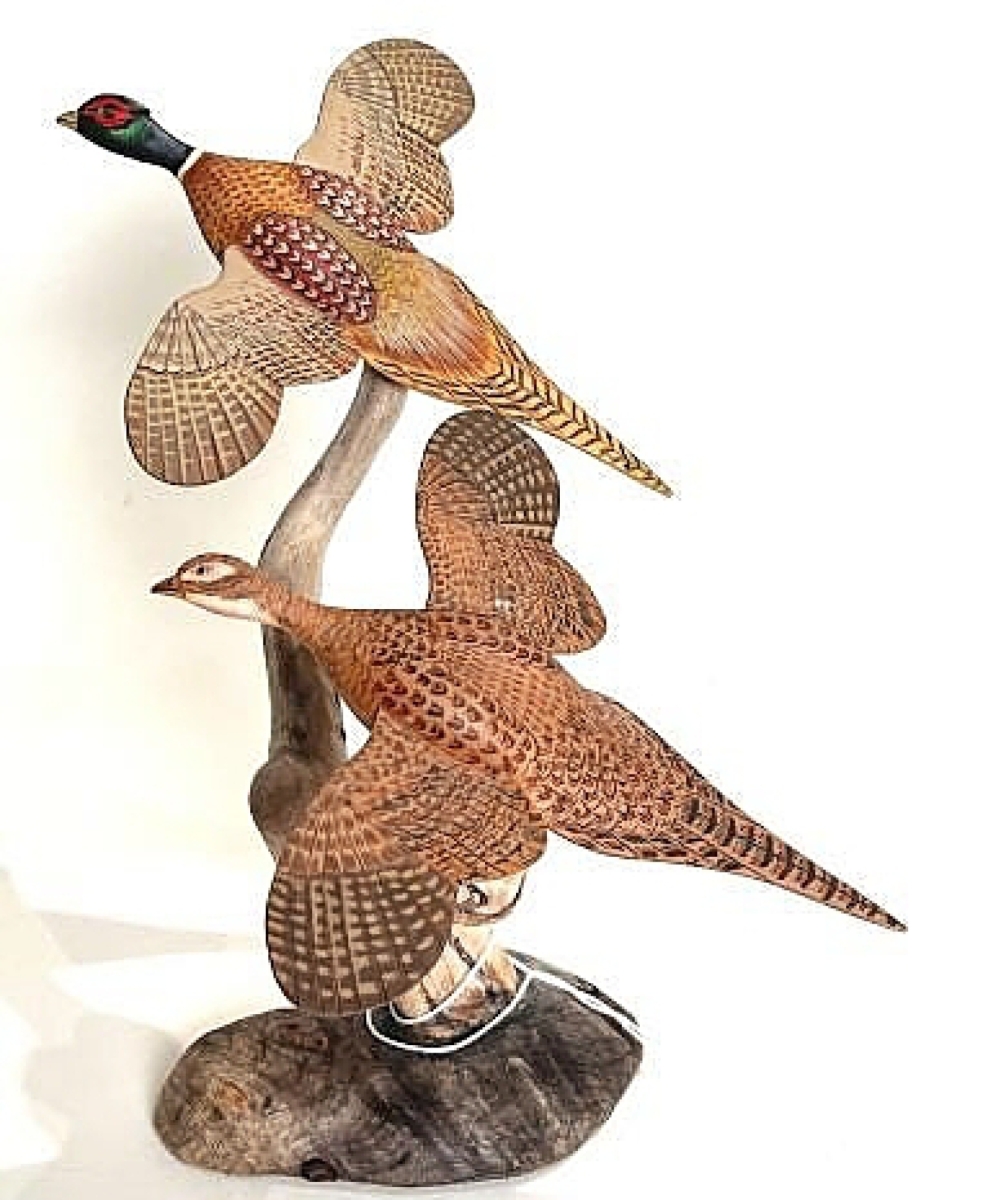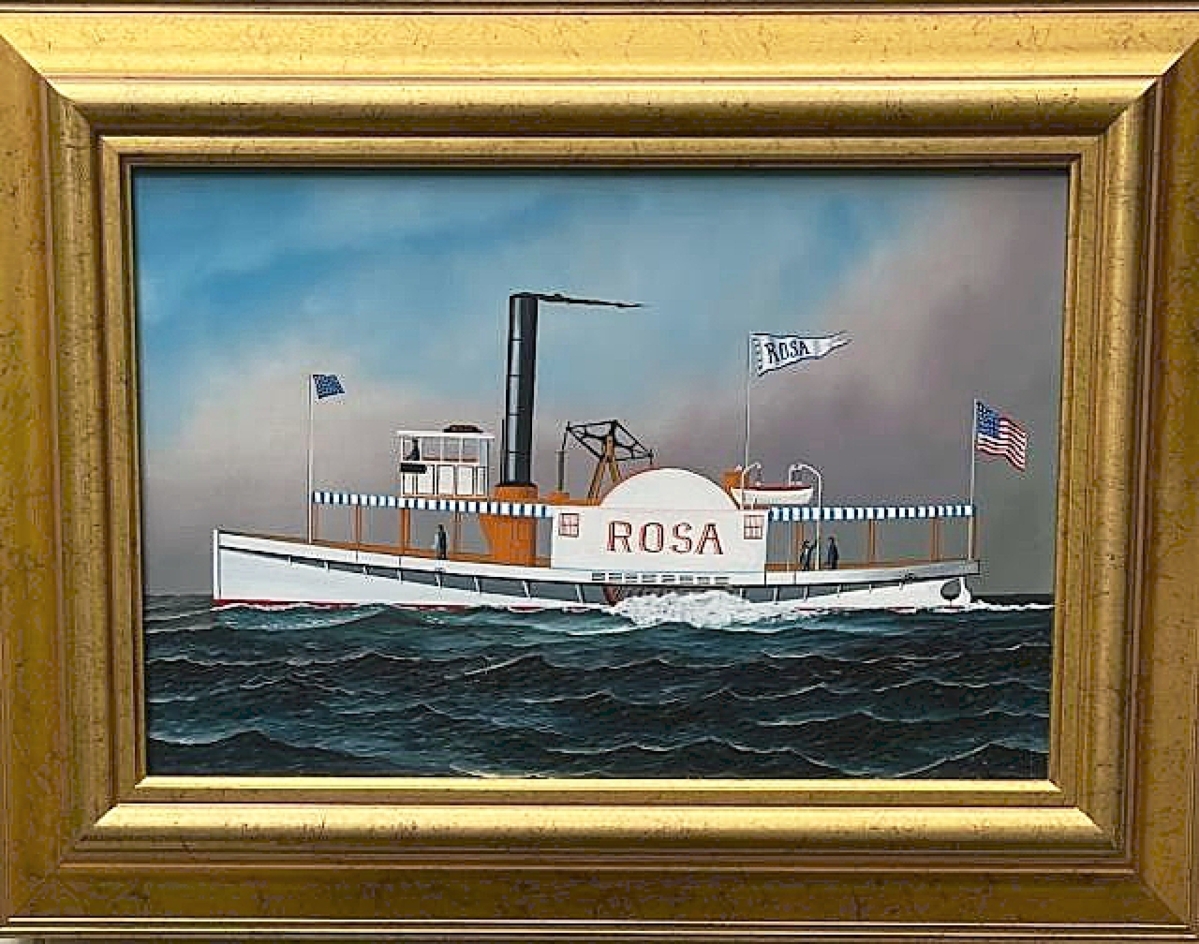
Setting a new record for an Elmer Crowell miniature was a mallard hen that brought $9,840. Crowell depicted this hen in a rare forward pose, and it bore his blue paper label on the base. Its mate, a mallard drake, earned $1,599.
Review and Onsite Photos By Rick Russack
BARNSTABLE, MASS. – Ted Harmon, the founder of Decoys Unlimited, which he runs with his wife Judy, started collecting decoys at the age of 15 when he found six old decoys on a bottle dump a short distance from his home in Barnstable on Cape Cod. That was more than 60 years ago. One of those birds is still in his collection.
He is also a hunter that uses his decoys. His collection, which is still large, leans towards New England birds. He gravitated to an enduring interest in Elmer Crowell and said he regrets passing up on the opportunity of buying Crowell’s nearby home, barn and land when his children were still in school. His personal collection of Crowell decoys is well-known to collectors, and he is president of the A.E. Crowell American Decoy Foundation. In 2019, three of his “dust jacket” plovers by Crowell sold for more than $1.4 million.
Prior to this sale, Harmon said, “Don’t expect any $100,000 birds. That’s not what we’re selling. These are good, collectible decoys, many have been hunted over, many are by unknown or lesser known carvers, and there will be some very good buys here.” He was right about there not being any six-figure birds in the sale, but it still grossed $322,000.
This sale included about 80 miniature carvings, many by Crowell but other carvers as well. Numerous decorative carvings were also offered. Crowell’s miniatures were originally sold individually, and he also offered them in three different sets of 25; shorebirds, songbirds and ducks. He typed lists of the species included in each these sets (one, listing the set of 25 ducks, was included this sale and sold for $277) but also produced dozens of other species on special order. It’s estimated that he produced 192 different species. Birds in Wood and Paint by Joe Ellis is the standard reference for miniatures. Ted Harmon said that Crowell had a large library of books about various birds that were illustrated in various plumage and poses. He used those reference works when carving a species with which he was not familiar.

Ted Harmon in his living room. Some of his miniatures are on the mantel piece and the sporting painting above is a watercolor by Frank Benson. He said, “I’ve always wanted a Benson watercolor and now I have one.”
The sale’s top price, $15,990, more than two-and-a-half-times its estimate, was earned by a working decoy, and the second highest price was earned by a miniature mallard hen by Elmer Crowell, which sold for $9,840. There were numerous shore bird decoys and one, attributed to a Cape Cod carver, brought $4,182.
The top selling working decoy, bringing $15,990, was an early canvasback drake by James Holly, a Chesapeake Bay carver who died in 1935. In addition to decoys, Holly was also a well-known builder of a distinct style of gunning boat, known as “bushwack” boats, used by hunters on the Susquehanna Flats at the northern end of the Chesapeake Bay. In addition to canvasbacks, he also made mallards, redheads and blackheads. He learned his woodworking skills from his father, who also made decoys. Blowing away its estimate, a goldeneye drake by Martha’s Vineyard carver Allen P. Stuart sold for $5,535. Ted Harmon really liked this decoy, cataloging it thus: “Superb, mellow 100 percent original paint. Condition is excellent with a couple tiny rubs and chips off the tail. This is positively the finest example currently known to exist. We have never seen another anywhere in like condition.” A “self-bailing” brant by Joe Lincoln, one of Cape Cod’s most collectible makers, sold for $4,305, well below the estimate.
Harmon’s sale included close to 70 factory decoys made by a variety of companies. Mason factory decoys may be the most collected of all decoys. Unsurprisingly, they were well represented in the sale with a challenge-grade merganser hen bringing the highest price of the factory birds, $4,920. There were essentially three “grades” of Mason decoys, with the challenge grade being the mid-level. There were also decoys by the Dodge factory, one of which, a blue-winged teal drake, sold for $584. An Evans factory mallard drake sold for $522, a pintail drake by the Wildfowler factory sold for $308, and two mallard drakes by the Peterson factory each realized $308. There were also decoys by the Hays factory, the Herter factory and others. A good reference work to factory decoys in general is North American Factory Decoys by Trayer and for Masons the standard reference is Mason Decoys by Goldberger and Haid.

The highest priced decoy in the sale, finishing at $15,990, was this canvasback drake by James Holly, a Chesapeake Bay carver who died in 1935. In addition to carving decoys, Holly was a noted maker of small boats used by hunters, a skill he learned from his father.
As mentioned, there were about 80 miniature carvings in the sale, led by a mallard hen by Elmer Crowell, which earned $9,840, setting a new record for the type. Crowell depicted this hen in a rare forward pose, and it bore his blue paper label on the base. Its mate, a mallard drake, earned $1,599. The paper label on the base of a least sandpiper by Crowell identified the species and bore the number 13. It sold for $4,100. A miniature bufflehead hen, also with the blue paper label, reached $2,890. The catalog noted “Exhibiting the finest paint we have ever seen.”
It wasn’t only Crowell miniatures that drew collectors’ interest. A ruddy duck drake by Joe Lincoln earned $2,829. Also popular were a group of miniatures by Jess Blackstone, who moved to New Hampshire in 1933. A miniature ring-neck pheasant, number 11, brought $1,845. Blackstone numbered each of his birds on the base, indicating how many of that particular species he had made to that point in time. His yellow warbler, the first he made, numbered 1, brought $3,690. There were several other Blackstone miniatures in the sale, most of which sold in the $1,500 range. A pair of wood ducks on a single mount by James Lapham – another Cape Cod carver – brought $2,460, and a pair of Richardson’s grouse, only 2¾ inches tall on a single mount, by Allen King brought $2,337.
Shore bird decoys were well represented. One of Ted Harmon’s favorite decoys in the sale was a small red knot in winter plumage attributed to Lathrop Holmes of Kingston, Mass. The head was uplifted as if it was watching incoming birds landing. It was found in an early local home in Sandwich, Mass., on Cape Cod and retained its original surface with some minor gunning wear. It reached $4,182. A split tail plover by the same carver earned $2,768. One of a rig-mate pair of yellowlegs with raised wing tips by an unknown early Long Island carver brought $4,182, and its mate, which may have had a replaced beak, brought $2,214. Another early Long Island yellowlegs, made by William Southard of Seaford, went out for $1,169. It was one of a small group of decoys that had been owned by Adele Earnest, author of one the early books on decoy collecting, The Art of The Decoy: American Bird Carvings, originally published in 1965 and still in print.
A few days after the sale, Ted Harmon said, “It was our first internet-only sale. We used three platforms; our own, LiveAuctioneers and Bidsquare. There were some interruptions on Bidsquare, but in general, I’m quite satisfied with the way things went. It was an auction; some things brought more than I thought they would and some less. Our total, $322,000, was fine, and Crowell’s miniature mallard was a new record. Miniatures did well across the board. Judy and I are pleased, and we hope to have another sale soon. We’ve plenty of good stuff to sell.”
Prices given include the buyer’s premium as stated by For information, 508-362-2766 or www.decoysunlimitedinc.net.





























